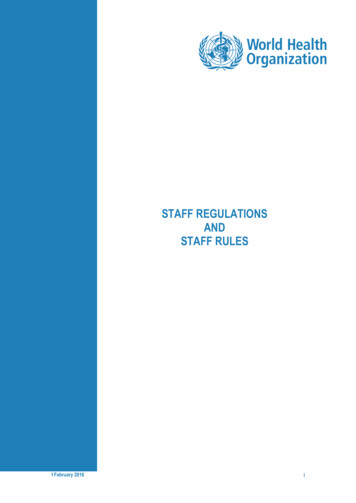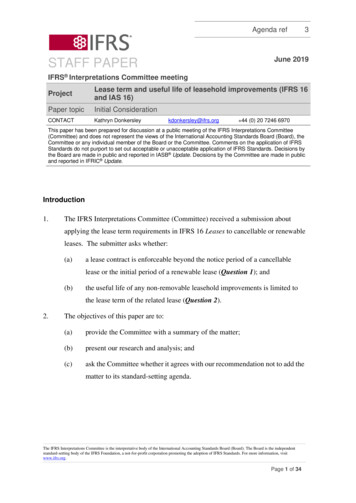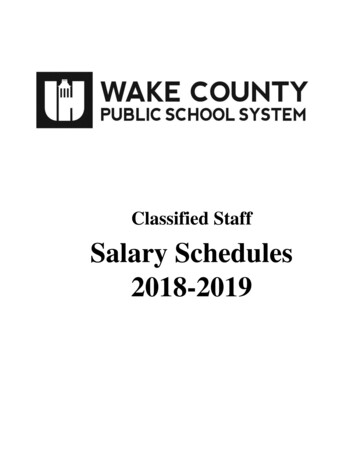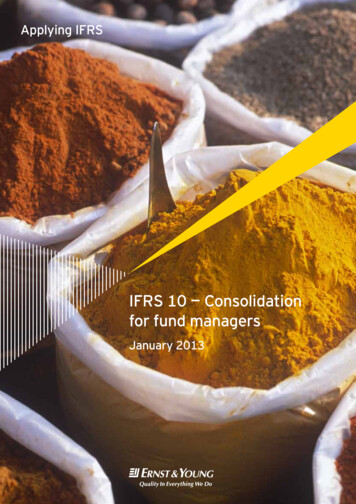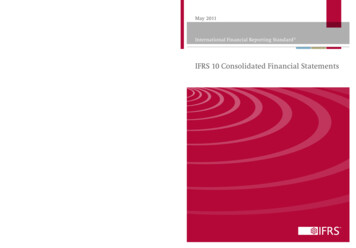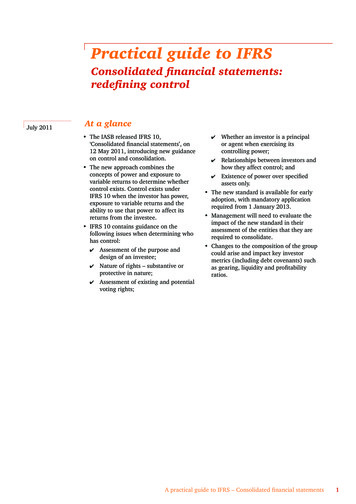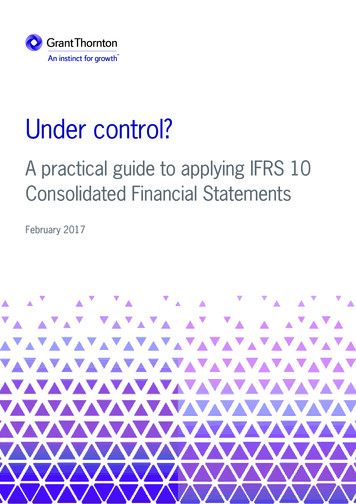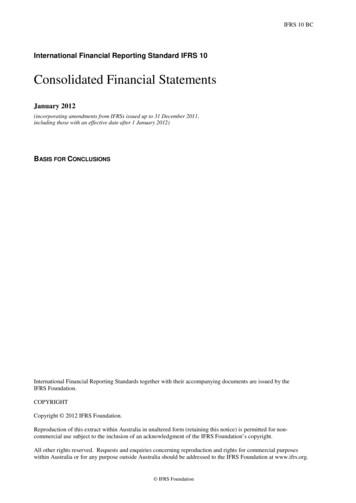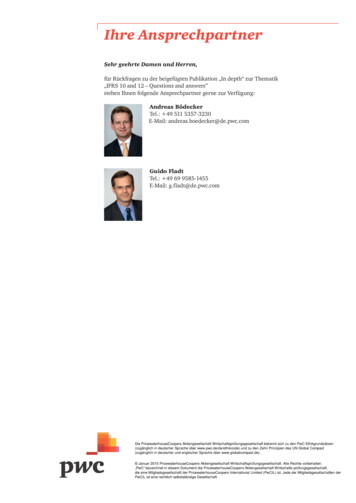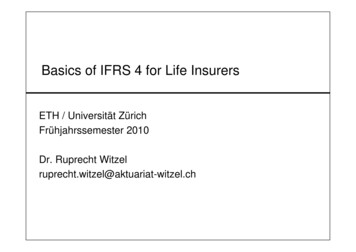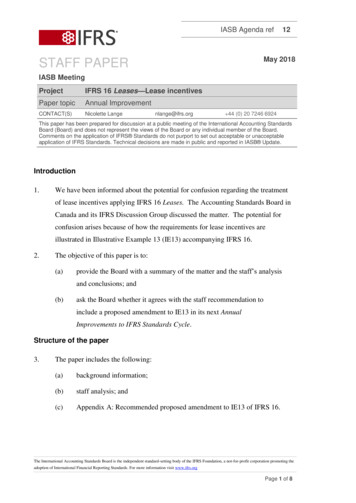
Transcription
IASB Agenda ref12May 2018STAFF PAPERIASB MeetingProjectIFRS 16 Leases—Lease incentivesPaper topicAnnual ImprovementCONTACT(S)Nicolette Langenlange@ifrs.org 44 (0) 20 7246 6924This paper has been prepared for discussion at a public meeting of the International Accounting StandardsBoard (Board) and does not represent the views of the Board or any individual member of the Board.Comments on the application of IFRS Standards do not purport to set out acceptable or unacceptableapplication of IFRS Standards. Technical decisions are made in public and reported in IASB Update.Introduction1.We have been informed about the potential for confusion regarding the treatmentof lease incentives applying IFRS 16 Leases. The Accounting Standards Board inCanada and its IFRS Discussion Group discussed the matter. The potential forconfusion arises because of how the requirements for lease incentives areillustrated in Illustrative Example 13 (IE13) accompanying IFRS 16.2.The objective of this paper is to:(a)provide the Board with a summary of the matter and the staff’s analysisand conclusions; and(b)ask the Board whether it agrees with the staff recommendation toinclude a proposed amendment to IE13 in its next AnnualImprovements to IFRS Standards Cycle.Structure of the paper3.The paper includes the following:(a)background information;(b)staff analysis; and(c)Appendix A: Recommended proposed amendment to IE13 of IFRS 16.The International Accounting Standards Board is the independent standard-setting body of the IFRS Foundation, a not-for-profit corporation promoting theadoption of International Financial Reporting Standards. For more information visit www.ifrs.orgPage 1 of 8
Agenda ref12Background information4.Paragraphs 24 and 26 of IFRS 16 require a lessee to include lease payments in theinitial measurement of the right-of-use asset and lease liability1.5.Appendix A to IFRS 16 defines lease payments and lease incentives as follows(emphasis added):Lease Payments:Payments made by a lessee to a lessor relating to the rightto use an underlying asset during the lease term, comprisingthe following:(b)fixed payments (including in-substance fixedpayments), less any lease incentives;(c)variable lease payments that depend on an index or arate;(d)the exercise price of a purchase option if the lessee isreasonably certain to exercise that option; and(e)payments of penalties for terminating the lease, if thelease term reflects the lessee exercising an option toterminate the lease.For the lessee, lease payments also include amountsexpected to be payable by the lessee under residual valueguarantees. Lease incentives:Payments made by a lessor to a lessee associated with alease, or the reimbursement or assumption by a lessor ofcosts of a lessee.6.IE13 illustrates how a lessee measures right-of-use assets and lease liabilities.Part 1 of IE13 illustrates the initial measurement requirements in IFRS 16, andPart 2 of IE 13 the subsequent measurement requirements. The matter raised1Lease payments made at or before the commencement date are not part of the lease liability recognised atthat date but are part of the right-of-use asset.IFRS 16 Lease incentives Annual ImprovementPage 2 of 8
Agenda ref12relates to initial measurement only. The relevant excerpt from the fact pattern inPart 1 of IE13 is as follows (emphasis added):Lessee enters into a 10-year lease of a floor of a building,with an option to extend for five years. Lease payments areCU50,000 per year during the initial term and CU55,000 peryear during the optional period, all payable at the beginningof each year. To obtain the lease, Lessee incurs initial directcosts of CU20,000, of which CU15,000 relates to a paymentto a former tenant occupying that floor of the building andCU5,000 relates to a commission paid to the real estateagent that arranged the lease. As an incentive to Lesseefor entering into the lease, Lessor agrees to reimburseto Lessee the real estate commission of CU5,000 andLessee’s leasehold improvements of CU7,000.7.The relevant excerpt from the conclusion in Part 1 of IE13 is as follows(emphasis added):At the commencement date, Lessee makes the leasepayment for the first year, incurs initial direct costs, receiveslease incentives from Lessor and measures the leaseliability at the present value of the remaining nine paymentsof CU50,000, discounted at the interest rate of 5 per centper annum, which is CU355,391.Lessee initially recognises assets and liabilities in relation tothe lease as follows:Right-of-use assetCU405,391Lease liabilityCU355,391Cash (lease payment for the first year)Right-of-use assetCU20,000Cash (initial direct costs)Cash (lease incentive)Right-of-use assetCU50,000CU20,000CU5,000CU5,000Lessee accounts for the reimbursement of leaseholdimprovements from Lessor applying other relevantIFRS 16 Lease incentives Annual ImprovementPage 3 of 8
Agenda ref12Standards and not as a lease incentive applying IFRS16. This is because costs incurred on leaseholdimprovements by Lessee are not included within thecost of the right-of-use asset.Question raised8.The question raised asked why, in IE13, the lessee did not consider thereimbursement relating to leasehold improvements to be a lease incentive asdefined in IFRS 16. We were informed that the illustration in IE13 has raisedquestions about how to read and apply the definition of lease incentives inIFRS 16.Staff AnalysisThe role of Illustrative Examples9.Illustrative Examples accompany, but are not part of, a particular IFRS Standard.Illustrative Examples are therefore not authoritative. The rubric before theillustrative examples in IFRS 16 notes that ‘they illustrate aspects of IFRS 16 butare not intended to provide interpretative guidance’. Paragraph IE1 of IFRS 16states:These examples portray hypothetical situations illustratinghow an entity might apply some of the requirements inIFRS 16 to particular aspects of a lease (or other contracts)on the basis of the limited facts presented. The analysis ineach example is not intended to represent the only mannerin which the requirements could be applied, nor are theexamples intended to apply only to the specific industryillustrated.10.Illustrative Examples are therefore not intended to provide an answer to anyparticular fact pattern, nor introduce new requirements or guidance. Rather, theyare developed to help stakeholders understand the requirements in the Standard byillustrating their application using hypothetical examples.IFRS 16 Lease incentives Annual ImprovementPage 4 of 8
Agenda ref12The rationale for the development of IE1311.The Board developed IE13 to illustrate the requirements in IFRS 16 for initial andsubsequent measurement of a right-of-use asset and lease liability.12.More specifically, the inclusion in the example of payments from the lessor to thelessee (in relation to both real estate commission and leasehold improvements)was intended to illustrate when such payments meet the definition of leaseincentives because they are associated with the lease and when not.13.The comments received, however, highlight that the drafting of IE13 in thisrespect may not be as precise as it might have been. With respect to the paymentsfrom the lessor related to leasehold improvements, IE13 concludes that the lesseedoes not account for those payments as lease incentives applying IFRS 16 butapplies other relevant Standards. The explanation provided—‘this is becausecosts incurred on leasehold improvements by Lessee are not included within thecost of the right-of-use asset’—implies that these payments are associated with theleasehold improvements (which the lessee accounts for applying other Standards),and not with the lease. However, in order to be sufficiently precise, we think thefact pattern and explanation provided in IE13 would have needed to state moreclearly that these payments did not meet the definition of lease incentives inIFRS 16 (ie the payments were not associated with the lease and were not thereimbursement or assumption by the lessor of costs of the lessee). For example,IE13 might have explained that these payments from the lessor relate to the costof leasehold improvements (paid for by the lessee) from which the lessor expectedto benefit, or alternatively explained that these payments were negotiatedseparately from the lease.14.With the benefit of hindsight, we think that the fact pattern and explanation inIE13 regarding payments from the lessor relating to leasehold improvementscould have been drafted more precisely than they were.Should any change be proposed to IE13 in this respect?15.Illustrative Examples provide non-authoritative material that accompanies aparticular Standard. Because Illustrative Examples are not authoritative, somemight question whether there is a need to propose any amendment to IE13 even ifIFRS 16 Lease incentives Annual ImprovementPage 5 of 8
Agenda ref12the Board were to agree with the staff’s analysis in paragraphs 11-14 above.Some might suggest that if there is any possible confusion between theauthoritative requirements in IFRS 16 and the non-authoritative illustration inIE13, then an entity would apply the requirements in the Standard and, thus, thereis no need to propose a change to IE13. In addition, proposing a change, albeit tonon-authoritative material accompanying IFRS 16, so close to the effective date of1 January 2019 has the potential to be disruptive to entities’ implementationactivities.16.Although strictly speaking an amendment to IE13 may not be required, we seebenefit in removing the potential for confusion that has been highlighted to us.Any amendment to IE13 would not change the authoritative requirements inIFRS 16 and, thus, the potential for disruption to implementation would beexpected to be low.17.The Board’s Annual Improvements Cycle exists for amendments that are limitedto changes that either:(b)clarify the wording in a Standard; or(c)correct relatively minor unintended consequences, oversights orconflicts between existing requirements of Standards2.18.If the Board agrees with our analysis above, then we think a change to IE13regarding payments from the lessor relating to leasehold improvements wouldmeet the criteria for Annual Improvements.Proposed Amendment to IE1319.Appendix A to this paper outlines our recommended proposed amendment toIE13—we recommend removing from the example the illustration of paymentsfrom the lessor relating to leasehold improvements.20.We considered two possible ways of amending IE13:(a)2the first is as recommended in Appendix A to this paper.Paragraphs 6.11–6.14 of the Due Process Handbook.IFRS 16 Lease incentives Annual ImprovementPage 6 of 8
Agenda ref(b)12the second is to change the fact pattern and explanation along the linesof the following:21.(i)to change the fact pattern to state that the lessor agrees topay CU7,000 to the lessee for costs of leaseholdimprovements from which the lessor expects to benefit.(ii)to change the explanation within the conclusion to statethat the payment from the lessor for leaseholdimprovements is not associated with the lease, nor does itrepresent the reimbursement or assumption of costs of thelessee.We recommend the first of these options on the grounds that:(a)the second option has the potential to raise new questions, which wouldbe unhelpful to stakeholders in implementing IFRS 16; and(b)we think it is not essential to illustrate lease incentives in an example.In considering all the requirements in IFRS 16, we think little is lost byremoving this aspect of IE13.Transition Requirements22.Because the amendment proposed is to non-authoritative material accompanyingIFRS 16, there is no need for the Board to consider transition or an effective date.Question for the BoardDoes the Board agree with our recommendation to propose anamendment to Illustrative Example 13 accompanying IFRS 16 in itsnext Annual Improvements to IFRS Standards Cycle? Appendix A tothis paper outlines the recommended proposed amendment.IFRS 16 Lease incentives Annual ImprovementPage 7 of 8
Agenda ref12Appendix A: Recommended proposed amendment to IllustrativeExample 13 in paragraph IE5 of IFRS 16A1.If the Board decides to propose an amendment to IE13, we recommendremoving from the example the illustration of payments from the lessor relatingto leasehold improvements as follows (text proposed for deletion is struckthrough):Part 1—Initial measurement of the right-of-use asset and the lease liabilityLessee enters into a 10-year lease of a floor of a building, with an option to extend for fiveyears. Lease payments are CU50,000 per year during the initial term and CU55,000 peryear during the optional period, all payable at the beginning of each year. To obtain thelease, Lessee incurs initial direct costs of CU20,000, of which CU15,000 relates to apayment to a former tenant occupying that floor of the building and CU5,000 relates to acommission paid to the real estate agent that arranged the lease. As an incentive to Lesseefor entering into the lease, Lessor agrees to reimburse to Lessee the real estate commissionof CU5,000 and Lessee’s leasehold improvements of CU7,000.At the commencement date, Lessee concludes that it is not reasonably certain to exercisethe option to extend the lease and, therefore, determines that the lease term is 10 years.The interest rate implicit in the lease is not readily determinable. Lessee's incrementalborrowing rate is 5 per cent per annum, which reflects the fixed rate at which Lessee couldborrow an amount similar to the value of the right-of-use asset, in the same currency, for a10-year term, and with similar collateral.At the commencement date, Lessee makes the lease payment for the first year, incurs initialdirect costs, receives lease incentives from Lessor and measures the lease liability at thepresent value of the remaining nine payments of CU50,000, discounted at the interest rateof 5 per cent per annum, which is CU355,391.Less
leasehold improvements (which the lessee accounts for applying other Standards), and not with the lease. However, in order to be sufficiently precise, we think the fact pattern and explanation provided in IE13 would have needed to state more clearly that these payments did not meet the definition of lease incentives in IFRS 16 (ie the payments were not associated with the lease and were not .
